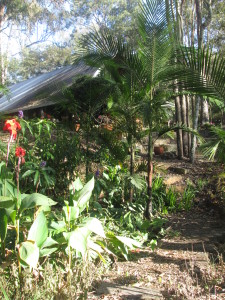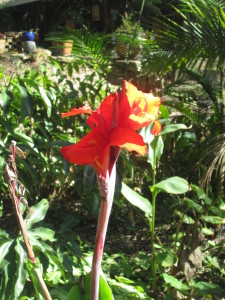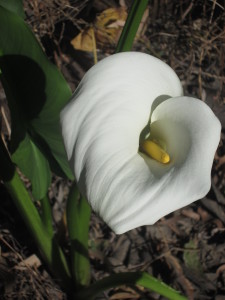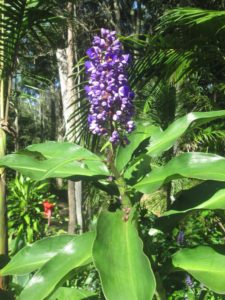_______________________________________________________________________________________________
Note: I would like to share with you through these few words, photographs and hyperlinked websites, a 3 Dimensional experience as though you were actually there with us. Click on any photograph and it should enlarge to different size ….. at least half a screen or size full screen. It will be clearer in detail than the photo in the post. It will be as if you were really there looking at the actual scene. You are an arm chair traveller with us.
___________________________________________________________________________________________________
A native rainforest tree, the Native Gardenia called Randia Fitzalanii …. see the many images of the tree. It grows as a woody shrub or small tree some 3–10 m (9.8–32.8 ft) in height.
The trunk is covered by smooth grey bark. The large glossy dark green leaves are obovate to oval-shaped and range from 10–18 cm (3.9–7.1 in) long by 3–5 cm (1.2–2.0 in) wide.
The yellowish veins and midrib are prominent on the leaf. The new growth is a bright lime green in colour. The small (2-2.5 cm or 1 inch) white fragrant flowers appear from September to November, occur singly and have five lanceolate petals around a tube. The round or oval-shaped fruit is 3–4 cm in diameter and ripens in April to June. The fragrance of the flowers resembles that of the common gardenia, and fruit can be eaten fresh.
….. Bangalow Palms above and below ….
Fast growing tall native palm suited to cool climate planting in sheltered locations. Grows 15-20m in ideal conditions, perfect for creating a grand entrance or lining a driveway. Plant alongside big leafy plants like ginger, fatsia, and cordyline for a tropical feel in your garden.
______________________________________
… Newly Planted Rainforest Garden area from 2012 ….

… The garden area in April 2016 …. four years on from 2012 when the garden was planted …. …. a small section of our rainforest garden …. it has a mixture of bangalow palms (Australian rainforest palms) and colourful broad leaved subtropical plants such as the red flowered Canna lily and the white – whorled Arum lily below ….







White – whorled Arum lily

Yellow Ginger



Cordyline petiolaris or Broad-leaved palm lily
Leaves 30 to 80 cm long, and 4 to 12 cm wide,[2] elliptic in shape. Leaves on long unrolled leaf stalks. The species name petiolaris refers to these long stems.
Flowering occurs from late winter to spring, being white or lilac in colour. Fruit is a red berry, 7 to 10 mm in diameter. The fruit can persist on the plant for many months. This species propagates easily from seeds or stem cuttings.
Not as widely seen in cultivation as Cordyline australis, however it is also well suited to gardens with moist soils in semi shade. It is not frost tolerant. Also suited as an indoor pot plant.

Blue Ginger ( Dichorisandra thyrsiflora)
__________________________________________________________________________________________________________
Rainforest Trees on the Opposite Side Of the Driveway

Moreton Bay Fig
This tree was planted as a 300 mm high nursery pot in the late 1980’s. Now it has a trunk 1.0 metre ++ in diameter. See the photo below. These trees love moisture and the growth of this tree has been from the adjacent septic tank above it. The septic tank takes in the kitchen washup water, the shower water and washing water. About ten years ago when the tank was full, we could pump it out with long hose on one our ten garden rooms. When we got a good bore put in in 2015, we didn’t need the septic tank. Now excess water spills out from under the concrete cover and soaks into the rich root zone around the fig tree. There is now a new Moreton Bay fig as a young tree growing beside the parent. See the photo above ….. the small tree on the righthand side of thee big one.
____________________________________________________________________________________________________________
Ficus macrophylla
Ficus macrophylla is called a strangler fig because seed germination usually takes place in the canopy of a host tree, where the seedling lives as an epiphyte until its roots establish contact with the ground, when it enlarges and strangles its host, eventually becoming a freestanding tree by itself. Individuals may reach 60 m (200 ft) in height. Like all figs, it has an obligate mutualism with fig wasps; figs are pollinated only by fig wasps, and fig wasps can reproduce only in fig flowers. Many species of birds, including pigeons, parrots, and various passerines, eat the fruit.
Ficus macrophylla is widely used as a feature tree in public parks and gardens in warmer climates such as California, Spain, Portugal, Italy, Malta, northern New Zealand (Auckland), and Australia. Old specimens can reach tremendous size, and their aggressive root system renders them unsuitable for all but the largest private gardens.


A slowly growing rainforest tree.

Another slowly growing rainforest trees above and below. When grown, the dark green foliage blends with the dark shady green of the Moreton Bay fig above it.

_____________________________________________________________________________
The Rest of the Rainforest Garden Room
… Possum in the branches of a low growing rainforest tree in the middle of
the day …. instead of the night when they come out ……
From Wikipedia, the free encyclopedia: Alocasia macrorrhizos is a species of flowering plant in the arum family, Araceae, that it is native to rainforests from Malaysia to Queensland and has long been cultivated on many Pacific islands and elsewhere in the tropics. Common names include Giant Taro and Elephant Ear Taro, while words for the plant in the various Polynesian languages include Kape (Futunan, Niuean, Tongan, Wallisian), ʻApe (Cook Islands Māori, Tahitian, Hawaiian), “ta’amu” in Samoan language, and Pulaka (Tuvalu). In Australia, it is known as the “cunjevoi” (although that term also refers to a marine animal). It is edible if cooked for a long time but its sap irritates the skin due to calcium oxalate crystals, or raphides which are needle-like. Alocasia species are commonly found in marketplaces in Samoa and Tonga and other parts of Polynesia. The varieties recognized in Tahiti are the Ape oa, haparu, maota, and uahea. The giant heart-shaped leaves make impromptu umbrellas in tropical downpours.
__________________________________________________________


The lilly pilly is one of the most popular plants in Australia today, particularly for hedging and topiary.
Lilly pillies are evergreen rainforest plants with glossy green leaves. Many varieties have flushes of colourful new growth, ranging from brilliant pink to a red-brown. In spring to early summer most lilly pillies have fluffy white or greenish flowers followed by long lasting red, purple or whitish berries. There are many, many species and cultivars on the market. Of these, a few are misnamed, while some perform better than others in gardens.
________________________________________________________
RAINFOREST TREES ON OUR LOWER DRIVEWAY


A Moreton Bay Fig I planted in the late 1980’s. It was only a 500mm plant when it was planted. Now it is a tall dense tree to 100 metres high and has a trunk at least a metre in thick. There is also a Moreton Bay Fig sapling growing beside it which is 20 metres high. Moreton Bay Figs like a lot of moisture and the soil around these trees have ample runoff water from our concrete sullage tank overflow. The ample runoff water is from our kitchen and showering water. It just cascades from the concrete sullage tank and onto the ground above the trees. About five years ago however, we didn’t allow this water to be wasted as it was pumped out on the ten garden rooms but now we have good bore which gives us ample water.


Other small

________________________________________________________
See the next post: Post 5: Subtropical Garden Room
__________________________________________________________










